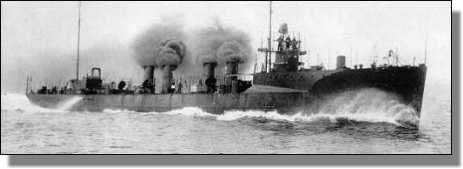

The first MCKEAN (DD-90) was laid down by Union Iron Works, San Francisco, Calif., 12 February 1918; launched 4 July 1918; sponsored by Miss Helen La Monte Ely; and commissioned at San Francisco 2O February 1919, Lt. Comdr. Raleigh C. Williams in command.
MCKEAN served in the Atlantic from 1919 to 1922; made a cruise to European waters between May and July 1919; operated primarily out of New York and Charleston; and decommissioned at Philadelphia 19 June 1922.

Reclassified APD-5 on 2 August, 1940, she recommissioned at Norfolk 11 December 1940, Lt. Comdr. Thomas Burrows in command, and resumed duty with the fleet. Following the outbreak of war in the Pacific 7 December 1941, MCKEAN departed the east coast 10 May 1942 and reached the South Pacific 20 July to prepare for the invasion of the Solomons. She landed troops at Tulagi 7 August and during the next several months made escort and supply runs from bases in New Caledonia and the New Hebrides to American positions in the southern Solomons. She departed the South Pacific 31 January 1943; and, after completing a cruise to the west coast for overhaul, she resumed escort and patrol operations between the New Hebrides and the Solomons 21 June. Between July and November she took part in amphibious operations in the central Solomons, landing troops at beachheads on New Georgia and Rendova. In addition she patrolled the waters off Guadalcanal and up the Slot to New Georgia. In October she completed preparations for operations n the Treasury Islands and Bougainville. She landed fighting men on Mono Island 27 October, including a construction team which installed a vital search radar in less than a week's time. Following the brilliant American naval victory over Japanese forces in the Battle of Empress Augusta Bay during the darkness of 2 November MCKEAN steamed with a reinforcement convoy to Bougainville and on the 6th landed marines near Cape Torokina, Empress Augusta Bay. She carried additional troops to Bougainville 11 November, thence returned to Guadalcanal for yet another troop run. With 185 marines embarked, MCKEAN sailed up the slot late 15 November. As she approached Empress Augusta Bay early 17 November, she was attacked by a torpedo plane which launched a torpedo off the starboard quarter. MCKEAN turned to avoid the deadly weapon; but at 0350 the torpedo struck the starboard side, exploding the after magazine and depth charge spaces and rupturing fuel oil tanks. Flaming oil engulfed MCKEAN aft of the No. 1 stack, and she lost all power and communications. Burning oil on the water killed men who were blown or jumped overboard. Her skipper, Lt. Comdr. Ralph L. Ramsey, ordered her abandoned at 0355; at 0400 she began to sink by the stern. He went over the side 12 minutes later, her forward magazine and oil tank exploded at 0415; and her stacks disappeared at 0418. Sixty-four of her complement and 52 of her embarked troops died from the explosions or flames. The survivors were picked up by rescuing destroyers. MCKEAN received four battle stars for World War II service. The story of the sinking of APD-5 as told by the son of a survivor is "The Epitath of a Dragon"
The second USS McKEAN (DD-784) was laid down by Todd Pacific Shipyards, Inc., Seattle, Wash., 15 September 1944; launched 31 March 1945. She was a Gearing class destroyer. She was christened in honor of Commodore William Wister McKean, commander of the Federal Gulf Squadron during the Civil War.
Displacement: 1,090 tons
Standard Displacement: 1,154 tons
Length: 314 feet 4 inches
Beam: 30 feet 10 inches
Draught: 9 feet 2 inches
Machinery: four White-Foster boilers;
two shaft Parsons turbines
Shaft horsepower: 26-28,000
Performance: 24,200 shp for 35 knots
Range: 2,500 nautical miles at 20 knots
Designed complement: Officers: 5; Enlisted 95
Guns: four 4 inch/50 Cal; one 3 inch
one 1-pounder, two 3-inch/23cal (AA battery)
three 30-cal machine guns
Torpedoes: twelve 21 inch